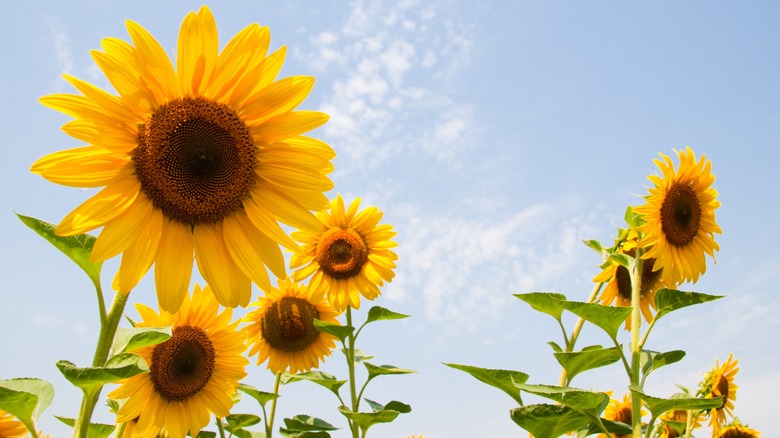Planting This Gorgeous Flower May Result In An Unwanted Spider Problem
You may already know that sunflowers will brighten your property when you plant them. They give your gardens a boost of eye-catching yellow colors, an impressive texture with their seed heads, and a significant height that's sure to catch the eye. They aren't perfect, though, as there are pros and cons to planting sunflowers in the garden. Some of the more obvious downsides include attracting animals like squirrels that want to eat the seeds and requiring significant cleanup in the fall, especially if the seeds are large. An additional potential downside that may not be as widely known is the fact that sunflowers can draw spiders in large numbers to your garden.
"Spiders are often drawn to taller plant specimens, given the added leverage these afford spiders to spin larger and more lucrative webs," Andrew Gaumond, horticulturist, botanist, and director of content at Petal Republic, told BestLife. Some arachnids, he adds, "have also evolved to camouflage themselves amongst the bright petals of the sunflower and lay in wait for incoming insects."
If you have a fear of spiders (called arachnophobia) or if you simply don't like the idea of walking into sticky webs while meandering through your garden, you may be wary of planting sunflowers. However, spiders are beneficial, too, as they feed on pesky insects that you may not want to see near your home or in your garden. They can also pollinate flowers in the garden.
How do I know sunflowers are attracting spiders to my garden and not something else?
If you are seeing an abundance of spiders in your garden after planting sunflowers, these tall plants are likely what caused it. Some varieties of sunflowers can be as tall as 15 feet, but most of them reach closer to five or six feet, which the spiders find ideal for catching bugs as they fly. However, other plants also can bring about a spider infestation, including tall plants like corn stalks. If you allow tall weeds to exist among the more desirable plants in a natural garden, they can deliver protection from harsh sunlight, which is one of the things these arachnids are seeking. If you add quite a bit of mulch to the space, which creates a moist environment, this also may encourage spiders to move into the space (as well as other insects).
Ultimately, though, arachnids are drawn to tall stalks like sunflowers so they can build webs that are well off the ground to snag flying insects. Such creatures may construct webs among sunflower plants and other areas that are at a height, like between trees and under the eaves of your home. You may see spiders spinning webs on tall ornamental grasses as well.
Are spiders good or bad to have around my sunflowers in the garden?
Spiders typically will be beneficial to a garden — and to the sunflowers in it — because they can eat insects that could cause harm to your plants. Aphids and beetles could chew on and damage your plants, and may even spread fungal and bacterial diseases between different plants, causing harm to them. By eating them, arachnids help reduce this problem. They may eat wasps or mosquitos, too. Perhaps the biggest danger of drawing spiders into your garden by planting sunflowers is that they may eat useful insects as well, such as ladybugs.
If a spider weaves a web on a plant, including sunflowers, it doesn't really harm them. However, some people feel as though the webs serve as an eyesore and distract from the overall look of the garden. Other people may want to avoid having spiders living on their sunflowers because of arachnophobia. This is a real disorder that can cause extreme fear in people, resulting in symptoms like nausea, sweating, dizziness, and trouble breathing. People with this condition may wish to remove the sunflowers from their garden, but others can control their arachnophobia through exposure therapy.


